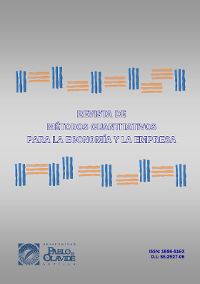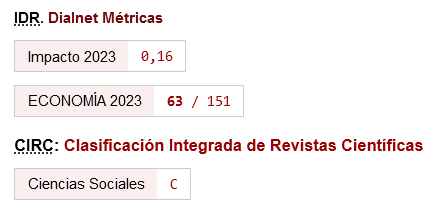Algunas aplicaciones de la Teoría de Lie a la Economía y las Finanzas
DOI:
https://doi.org/10.46661/revmetodoscuanteconempresa.2115Palabras clave:
Matemática Financiera, Matemática Económica, progreso técnico, opciones con barrera móvil, grupos de Lie, álgebras de Lie, Financial Mathematics, Mathematical Economics, technical progress, moving barrier options, Lie groups, Lie algebrasResumen
En este artículo, los autores pretenden mostrar y explicar cómo la Teoría de Lie se puede aplicar a la resolución de algunos problemas relativos a la Economía y a las Finanzas. Concretamente, se realiza un análisis de dos de esos problemas y se discuten tanto sus aspectos matemáticos como el acercamiento hecho desde la Teoría de Lie para su resolución. Igualmente, se indican los avances más recientes existentes en esta línea de investigación, mencionando también algunos problemas abiertos que pueden ser tratados en futuros trabajos.
Descargas
Citas
M. Armstrong (1996): Multiproduct Nonlinear Pricing. Econometrica 64, pp. 51–75.
S. Basov (2004): Lie groups of partial differential equations and their application to the multidimensional screening problems. Econometric Society 2004 Australasian Meetings 44.
T. Björk (2001): A geometric view of interest rate theory. En: E. Jouni, J. Cvitanic and M. Musuela (eds.): Option pricing, Interest Rates and Risk Management, Cambridge University Press, pp. 241–277.
T. Björk (2004): On the Geometry of Interest Rate Models. En: R.A. Carmona, E.C. Çinlar, I. Ekeland, E. Jouini, J. A. Scheinkman and N. Touzi (eds.): Paris-Princeton Lectures on Mathematical Finance 2003, Springer-Verlag, pp. 133–216.
T. Björk and C. Landén (2002): On the construction of finite dimensional realizations for nonlinear forward rate models. Fin. Stoch. 6, pp. 303–331.
J. Cox (1975): Notes on Option Pricing I: Constant Elasticity of Variance Diffusions. Working Paper, Stanford University.
J.C. Cox and S.A. Ross (1976): The Valuation of Options for Alternative Stochastic Processes. Journal of Financial Economics 3, pp. 145–166.
A. De Sanctis (2007): Lie Theory to Value Financial Derivatives with Time Dependent Parameters. Int. Math. Forum 2:10, pp. 499–503.
L.P. Eisenhart (1933): Continuous groups of transformations, Princeton University Press.
E.M. Fedriani y Á.F. Tenorio (2006): Progreso técnico: una aproximación desde la Teoría de Grupos de Transformaciones de Lie. Revista de Métodos Cuantitativos para la Economía y la Empresa 1, pp. 5–24.
A. Friedman (1964): Partial Differential Equations of Parabolic Type, Prentice-Hall.
R.M. Gaspar (2006): Finite Dimensional Markovian Realizations for Forward Price Term Structure Models. En: A.N. Shiryaev, M.R. Grossinho, P.E. Oliveira and M.L. Esquível (eds.): Stochastic Finance, Springer, pp. 265–320.
I. Hernández, C. Mateos, J. Núñez and Á.F. Tenorio (2008): Lie Theory: Applications to Problems in Mathematical Finance and Economics. Applied Mathematics and Computation. To appear.
I. Karatsas and S. Shreve (1997): Brownian Motion and Stochastic Calculus, Springer-Verlag.
C.F. Lo, C.H. Hui and P.H. Yuen (2000a): Constant elasticity of variance option pricing model with time-dependent parameters. Int. J. Theor. Appl. Fin. 3:4, pp. 661–674.
C.F. Lo, C.H. Hui and P.H. Yuen (2000b): Option risk measurement with time-dependent parameters. Int. J. Theor. Appl. Fin. 3:3, pp. 581–589.
C.F. Lo and C.H. Hui (2001): Valuation of financial derivatives with time-dependent parameters. Quantitative Finance 1, pp. 73–78.
C.F. Lo and C.H. Lui (2002): Pricing multi-asset financial derivatives with time-dependent parameters-Lie algebraic approach. Int. J. Math. Math. Sci. 32:7, pp. 401–410.
C.F. Lo and C.H. Lui (2006): Lie algebraic approach for pricing moving barrier options with time-dependent parameters, J. Math. Ann. Appl. 323:2, pp. 1455–1464.
R. Lu and Y.-H. Hsu (2005): Valuation of Standard Options under the Constant Elasticity of Variance Model, Int. J. Bus. Econ. 4:2, pp. 157–165.
T.M. Mitchell (1987): Toward empirical applications of Lie-group technical progress functions, Economics Letters 25, pp. 111–116.
S. Polidoro (2003): A Nonlinear PDE in Mathematical Finance. En: F. Brezzi, A. Buffa, S. Corsaro and A. Murli(eds.):Numerical Mathematics andAdvancedApplication, Springer, pp. 429–433.
R. Sato (1980): The impact of technical change on the holotheticity of production functions. Economic Studies 47, pp. 767–776.
R. Sato (1981): Theory of technical change and economic invariance. Application of Lie groups, Academic Press.
R. Sato and R.V. Ramachandran (1998): Symmetry and Economic Invariance: an introduction, Kluwer.
R.M. Solow (1961): Comment on Stigler. En: Output, Input and Productivity Measurement, Princeton University Press, pp. 64–68.
G.J. Stigler (1961): Economic problems in measuring changes in productivity. En: Output, Input and Productivity Measurement, Princeton University Press, pp. 47–63.
J. Wei and E. Norman (1963): Lie algebraic solution of linear differential equations. Journal of Mathematical Physics 4, pp. 575–581.
R. Wilson (1993): Non Linear Pricing, Oxford University Press.
Descargas
Publicado
Cómo citar
Número
Sección
Licencia
Derechos de autor 2008 Revista de Métodos Cuantitativos para la Economía y la Empresa

Esta obra está bajo una licencia internacional Creative Commons Atribución-CompartirIgual 4.0.
El envío de un manuscrito a la Revista supone que el trabajo no ha sido publicado anteriormente (excepto en la forma de un abstract o como parte de una tesis), que no está bajo consideración para su publicación en ninguna otra revista o editorial y que, en caso de aceptación, los autores están conforme con la transferencia automática del copyright a la Revista para su publicación y difusión. Los autores retendrán los derechos de autor para usar y compartir su artículo con un uso personal, institucional o con fines docentes; igualmente retiene los derechos de patente, de marca registrada (en caso de que sean aplicables) o derechos morales de autor (incluyendo los datos de investigación).
Los artículos publicados en la Revista están sujetos a la licencia Creative Commons CC-BY-SA de tipo Reconocimiento-CompartirIgual. Se permite el uso comercial de la obra, reconociendo su autoría, y de las posibles obras derivadas, la distribución de las cuales se debe hacer con una licencia igual a la que regula la obra original.
Hasta el volumen 21 se ha estado empleando la versión de licencia CC-BY-SA 3.0 ES y se ha comenzado a usar la versión CC-BY-SA 4.0 desde el volumen 22.










